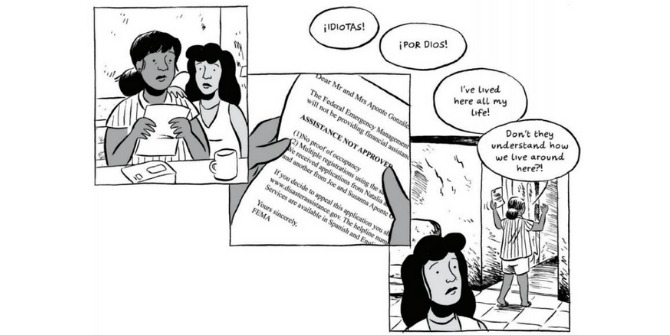 Academic writing is often criticised for being overly complicated and impenetrable to anyone outside of a small circle of experts. In this post Gemma Sou reflects on how communicating her research in the form of a graphic novel transformed her research practice. Not only making her research more representative and accessible to those involved, but also through reshaping her research and teaching practices and stimulating a creative dialogue between herself as the author of the text and the illustrator.
Academic writing is often criticised for being overly complicated and impenetrable to anyone outside of a small circle of experts. In this post Gemma Sou reflects on how communicating her research in the form of a graphic novel transformed her research practice. Not only making her research more representative and accessible to those involved, but also through reshaping her research and teaching practices and stimulating a creative dialogue between herself as the author of the text and the illustrator.
 On September 20, 2017, Hurricane Maria devastated the Caribbean island of Puerto Rico. Some of you might remember reading about the “biggest storm in Caribbean history!” or watching a news report about the “category 5 mega storm!”. For one year, I conducted ethnographic research, following 16 low-income Puerto Rican families to find out how they were affected by, and recovered from Maria. I’ve turned this research into a 20 page graphic novella (free to download). Although the graphic novella tells the story of a fictional family, “After Maria” is based on the experiences that tie together all of the Puerto Rican families I spoke to.
On September 20, 2017, Hurricane Maria devastated the Caribbean island of Puerto Rico. Some of you might remember reading about the “biggest storm in Caribbean history!” or watching a news report about the “category 5 mega storm!”. For one year, I conducted ethnographic research, following 16 low-income Puerto Rican families to find out how they were affected by, and recovered from Maria. I’ve turned this research into a 20 page graphic novella (free to download). Although the graphic novella tells the story of a fictional family, “After Maria” is based on the experiences that tie together all of the Puerto Rican families I spoke to.
Graphically illustrated research has expanded rapidly in academia. For example Lissa: A Story about Medical Promise, Friendship, and Revolution, Positive-Negatives, and Striking Women. Perhaps as a result of this rising interest, finding a graphic artist was surprisingly simple. I posted a pitch for my novella on a facebook page for UK based graphic artists and was met with many inquiries. I asked two of my favourite artists to sketch a scene I had written, and from there I decided to work with the very talented John Cei Douglas. At first there was a lot of back and forth between the two of us, as I wanted to ensure the integrity of the research and the voices and personalities of the people I spoke to in Puerto Rico. At the same time, John brought his expertise in visual storytelling and was fantastic at suggesting what dialogue to leave out, or which angle to draw a scene from for example. Here, I want to share some of the reasons why graphic illustration can be a powerful and enlightening way to communicate your research.
Creating ethical public representations of your research
If you research people, places and cultures that are represented in TV, film, social media, or the news, then it’s likely you’ve thought that popular culture misrepresents your work and the people that you speak to. Graphic novels, with their focus on character driven narratives, are able to communicate the rich lived experiences of all kinds of people to an outside audience. This can provide a more nuanced and ethical portrayal of your research and research participants.
In “After Maria” my priority was to construct ethical and respectful representations of the families I spoke to. I aimed to bring through the voice, personalities, and hidden everyday personal experiences of disaster ‘victims’. Graphic novellas afford this because you create three-dimensional characters who express their emotions and unique personalities. I also highlighted the capacities’ that families have to recover from disasters, thereby challenging the idea that people are passive and helpless victims. Yet, I have been careful not to over romanticise families’ resilience, as NGOs and government actors have a duty to do a lot more to support recovering families. If not, the burden of responsibility will continue to unjustly fall on shoulders of low-income families.
Making your research more democratic
Graphic novels offer what I think of as a more democratic opportunity for research participants to influence and understand the work of academics. A graphic novel may be far more useful to research participants than a research report, book, or journal article. When people can literally “see” themselves in a graphic novel, they are instantly invested. It is important that academics learn ways of communicating research findings through media that is appropriate and enjoyable for their participants. In my experience creating this graphic novella, participants feel more comfortable giving their input on how events, perspectives, and people are represented in a visual storytelling form. Finally, there is something about the physicality and durability of a print graphic novella that lends both legitimacy and longevity to the research it presents. It won’t be lost somewhere in the wilds of the endless Internet, or trapped behind the pay wall of an academic journal, but can be found on a shelf for future generations to discover.
Teaching in engaging and innovative ways
Graphic novels also offer new pedagogical avenues that can contribute to and support traditional teaching from academic texts. They combine the power of ethnographic research, with the unique aesthetic elements of graphic novels, as a sequential art, using pages, panels, visuals, dialogue, captions, and lettering to tell a story. They build strong characters that drive the narrative without being too intrusive. Graphic novels also use the visual medium to express non-human environmental elements in a form that is not overly didactic. This approach makes graphic novels excellent for critical analysis, because readers can use their wider understanding of theories, concepts and ideas they have learnt in class, or elsewhere, to unpack the stories images, dialogue, and narratives. Furthermore, this way of teaching is appreciated by students, who increasingly request different more visual approaches to teaching.
Releasing your inner creativity
The graphic novella is also about providing opportunities for researchers to work more creatively themselves. No longer holed up in a room alone writing for hours on end, researchers and graphic artists can share, push, pull, and compromise as necessary in the pursuit of a visual representation of research. This process has been challenging and exciting in equal measure. It has raised questions about what to leave out, what works narratively and aesthetically, but also about how to ensure the integrity of the research and of those being represented. To this end, it is important to work with a graphic artist who is sensitive to the research findings, but also has the skill and intuition to know what works visually.
Further information
You can freely download After Maria (in Spanish and English) and watch multimedia footage from the case neighbourhood here: https://www.hcri.manchester.ac.uk/research/projects/after-maria/
John Cei Douglas is a freelance illustrator based in London: www.johnceidouglas.com johnceidouglas@gmail.com
About the author
Dr. Gemma Sou is Lecturer in Disaster Studies in the University of Manchester: gemma.sou@manchester.ac.uk, she tweets @gemmasou and blogs at Rethinking Disasters.
P.S. I was inspired to publish in graphic form after reading the fantastic Lissa: A Story about Medical Promise, Friendship, and Revolution by Dr. Sherine Hamdy and Dr. Coleman Nye.
Note: This article gives the views of the author, and not the position of the LSE Impact Blog, nor of the London School of Economics. Please review our comments policy if you have any concerns on posting a comment below.










2 Comments